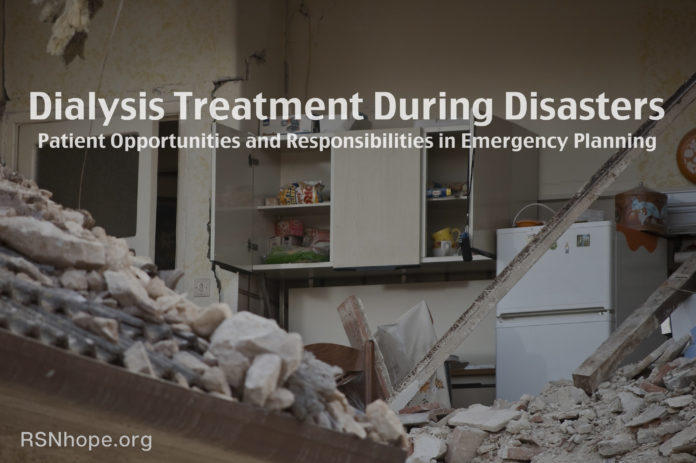Katrina and other devastating events in 2005 exposed problems in providing medical care to kidney patients in disasters as well as in providing food and shelter to the hundreds of thousands who were displaced from their homes. In response to the particular needs of kidney patients, the Kidney Community Emergency Response Coalition (KCERC) has formulated plans to ensure readily available dialysis care during disasters.
Resources Available
Many resources are available in print and online to help patients, dialysis units, and communities develop disaster plans that address the unique needs of those with kidney failure. The End-Stage Renal Disease (ESRD) Networks, the Centers for Medicare and Medicaid Services (CMS), the Federal Emergency Management Agency (FEMA), large dialysis organizations, and kidney patient, provider, and vendor groups are some of the entities that provide specific disaster preparation and response information for kidney patients. Perhaps the single best supplementary source is provided by CMS and is entitled “Preparing for Emergencies: A Guide for Patients on Dialysis.”
We hope this article will help the kidney care community in several ways, including:
Helping patients develop step-by-step, detailed written disaster plans, including diverse scenarios and primary and alternate approaches.
Assisting dialysis facilities in preparing quick-reference guides that summarize local resources and regional disaster plans to orient patients and staff.
The Necessity For Preparation
Every region of the country is at some risk for natural and man-made hazards, including hurricanes, floods, tornadoes, winter storms, wildfires, earthquakes, and acts of terrorism. Therefore, it is incumbent on all dialysis patients in every region of the country to prepare for disasters.
Patients have many potential sources of help when developing individualized disaster plans. Understanding emergency resource availability in the local area can help patients develop plans that take advantage of these resources and can help them develop approaches to address gaps in the plans. Patients should coordinate their emergency plans with their dialysis providers. They need to enlist their family and friends in the planning process and use these resources to help with transportation and access to care. Patients can also coordinate plans with other dialysis patients who live in the same area. This buddy system opens more possibilities for finding help in a disaster. Other potential sources of help include the local ESRD Network; kidney patient and faith-based groups; fraternal, service, and veterans’ organizations; and similar community groups.
Planning For a Disaster
All-Hazards Plan
Patients should become aware of the disasters likely to occur in their region. This information can be obtained by asking the dialysis facility staff and by visiting the FEMA website (see table below).
Although various disasters pose distinct challenges, we recommend that patients prepare an all-hazards plan. Most disasters pose problems with transportation, shelter, and communication. Preparing for planned emergencies may also help prepare for unplanned evacuations. The extent and duration of infrastructure damage will dictate the level of response needed to support the ongoing care for the patient. Patients must plan for altered dialysis schedules and possible relocation for continuing care.
Personalized Disaster Plans
Patients should develop their personalized disaster plans in coordination with dialysis facility staff.The staff should be aware of local disaster planning efforts, including those related to kidney care and general disaster issues.Many dialysis units have affiliations with one or more partner facilities, including nearby and more distant units, that can accommodate patients when they evacuate.
Preparation of patient-specific medical documents for evacuation should include:
- Medical problems (updated history and physical), including active viral (hepatitis and HIV status) and current bacterial infections (especially those caused by antibiotic-resistant bacteria such as certain staphylococcal and enterococcal infections).
- Medication names and doses and drug allergies.
- Life-support/resuscitation directives.
- Updated dialysis prescription including special “tickler” information pertinent to the individual.
- Dietary plans.
- Dry weight estimate.
- Names and contact information for patient’s nephrologist, other specialists, primary care physician, and dialysis unit.
- Copies of critical prescriptions or a record that these are on file with a particular pharmaceutical chain.
This information can be placed in sealed waterproof bags or on computer memory sticks and disks.
Items to Bring and Pre-Registration
Patients who are well-informed about their dialysis treatment prescription and medical history are better able to monitor their ongoing care during disasters. Patients who self-cannulate their vascular access (do their own needle-sticking) may find that they have fewer problems when they travel to a new facility.
Other items to bring during an evacuation include clothes, toiletries, water (two quarts), food, cell phone if available, photo identification, credit card, and cash or traveler’s checks. These items should be packed in a small suitcase or backpack that can be easily carried or rolled.
Some localities offer pre-registration for transportation and shelter use as part of the planning process. Registration may also provide an opportunity to arrange for special needs such as oxygen and wheelchairs. Unit social workers will be able to help with this process.
Home Patient Preparations
Home dialysis patients should identify in advance depots and dialysis units with supply stockpiles and those that offer support services during disasters. Information can be obtained from the patient’s home dialysis facility and from his/her provider supply company. Supplies can be shipped to the patient’s new location if timely notification is given.
When Should Patients Evacuate?
Disasters that will likely render critical infrastructure (transportation, communication, utilities) inoperable for three or more days are those that should prompt patients to evacuate from the disaster area. Early evacuation makes it possible to maintain regular dialysis schedules and minimizes health risks.
Predicted disasters: Dialysis patients should generally evacuate early, ahead of the general population (48-72 hours before the predicted disaster). The timing of the evacuation will also be affected by the time required to reach the safe locations where dialysis can be resumed. Traffic congestion should be considered when estimating travel times.
Certain Patients Should Evacuate Earlier
Certain categories of dialysis patients should evacuate even earlier, perhaps 72-96 hours before the predicted disaster. These include:
- Patients with other illnesses, mobility needs, or other special needs (oxygen, wheelchairs, etc.).
- Patients with certain infections such as hepatitis B, where dialysis options may be more limited.
- Those with access concerns including temporary or semi-permanent dialysis catheters or ongoing access infections or patency/cannulation difficulties. These issues may present evacuees with difficulty in resuming timely dialysis during disasters, especially in congested evacuation surge areas.
- Patients in urban or other areas likely to experience transportation difficulties
Unpredicted disasters: Patients should evacuate as soon as it is safe to do so.
Multiple Destinations
Multiple destinations should be considered for patients during an emergency evacuation, including:
- The homes of friends and families.
- Evacuation shelters. General population shelters are generally staffed by the American Red Cross. Special-needs shelters accommodate patients with medical needs. These shelters are typically set up in convention centers, sports arenas, and school buildings. Some states may offer special-needs shelters that are designated to receive dialysis patients. Nearly all evacuation shelters will accept family pets with the appropriate updated vaccinations.
- Transportation depots, staging areas, or meeting areas may be designated as pick-up sites for transportation to evacuation shelters.
Transportation and Contact Information
Transportation is a major problem during every disaster. Patients should develop various alternatives to make it more likely that some transportation source will be available. For those without cars and with limited financial resources, assistance should be identified early through the dialysis unit and community disaster assistance programs.
Kidney patient, faith-based, and local service organizations may be able to help with transportation needs. Patients who wait until a disaster happens may find it difficult to resume dialysis within a safe interval.
Patients should notify their families, dialysis facilities, and, if possible, the local ESRD Network of evacuation information including relocation updates, the timing of evacuation, and their intended destinations.
Coping With a Disaster
Where Can Patients Go For Treatments?
Patients can contact the KCERC national disaster hotline at (888) 33KIDNEY and learn which dialysis facilities are functioning and which can take additional patients.
Patients may also contact any ESRD Network or the KCERC website for open/closed unit status.
What if a Patient Cannot Evacuate?
If a kidney patient has not, or cannot, evacuate and is trapped within the disaster area, he/she should:
- Adhere to the emergency kidney diet, if possible.
- Seek to establish communication with emergency responders. If there is a pre-disaster registry, the responders may know the names and addresses of special-needs individuals such as dialysis patients and may make particular efforts to reach and evacuate these individuals.
- Consider locating to a medical staging area where the patient can be evacuated from the area. These may be airports, convention centers, or similar facilities.
The Road to Safety
If a kidney patient is on the road to safety during evacuation, he/she should:
- Travel with family members or a buddy, if possible.
- Have a map with open shelters (this information is available from local emergency centers) and open dialysis facilities (information available from the patient’s home dialysis facility, ESRD Network, and KCERC hotline).
How About the Emergency Room?
During disasters, emergency rooms and dialysis services in hospitals usually become overwhelmed, and treatments are delayed or curtailed.
Dialysis resources–including staff, equipment, and supplies–usually run short. Furthermore, hospital utilization should be reserved for true emergencies and may not be used for outpatient ambulatory care such as routine dialysis. Dialysis patients may wait hours only to be turned away, wasting valuable transportation time.
Can the Government Help?
In a major disaster, there are often too many needs and too few resources for most needs to be met promptly and effectively. Therefore, patients must be prepared to help themselves to the extent possible.
In many situations, there will be a delay of 72 hours or more before the full range of state and federal resources are deployed. Therefore, patients and dialysis providers must develop plans that are based on local resources, particularly for the first few days.
What About Communication?
During disasters, telephone service is often disrupted. Evacuees should bring telephone numbers of family or friends living outside the disaster area and contact them when they can.
Internet service may be available, at least to a limited degree. Dialysis facility and ESRD Network websites and web bulletin boards may be operational, enabling patients to learn which dialysis facilities are functioning.
The American Red Cross has an innovative program called the Safe and Well List. This Web-based tool allows individuals to exchange welfare information with family members and friends in the aftermath of a disaster. The site enables individuals to select standard messages indicating that they are safe and well, and family and friends can search the website using the individual’s name and telephone number or name and complete address.
Evacuation Shelters
On arrival at general population or special needs shelters, dialysis patients should immediately inform the medical staff of the urgency for regular hemodialysis or peritoneal dialysis (PD) treatments. Most shelters provide barracks-style living. Meals are provided but may be high in sodium.
Patients should discuss any particular medical needs including infection control issues with medical staff at the shelters.
Transmitting infection: Kidney patients with active conditions such as draining infections, urinary incontinence with resistant bacterial urinary infections, and bacterial peritonitis (for PD patients) may present a risk to other individuals.
Acquiring infection: Transplant patients may be at risk for acquiring infections from mass grouping that occurs during disasters. PD patients may be at risk for developing infectious complications if there is not an adequate clean-containment environment for exchanges.
Coping With Stress
During the crisis, kidney patients, like others, will focus on surviving: getting to safety, finding a place to stay, and locating a functioning dialysis unit. When their lives are disrupted—and especially when family, friends or pets are injured, missing or deceased, or homes are damaged or lost—they will go through the grieving process.
Signs of stress include:
- Trouble concentrating and remembering;
- Difficulty making decisions;
- Mentally replaying scenes of the disaster;
- Feeling sad or depressed;
- Having nightmares; and
- Feeling overwhelmed and out of control.
Strategies to cope with stress include:
- Get plenty of sleep;
- Eat nutritious food;
- Talk about feelings with other evacuees and staff; and
- Exercise daily.
Older Adult and Child Stress
Older adults may have particular problems with stress. The disaster may remind them of past losses, exacerbate chronic health problems, or threaten their ability to remain independent. It may be difficult for them to rebuild their lives as their emotional and financial resources are challenged. They are more likely to manifest apathy, confusion, and disorientation.
Children may manifest emotional stress in distinctive ways. They may have crying spells, express fear of the dark or of being alone, and may worry about things. Parents and caregivers should reassure children that they are safe, encourage them to talk about their feelings, tell them they are not responsible for what happened, and hold and comfort them frequently.
What Happens if a Patient Cannot Get Dialysis?
Each patient is different regarding when complications occur as a result of missed dialysis treatments. Patients risk illness and death without timely dialysis treatments.
Patients should discuss with their dialysis provider the specific complications they are at particular risk for and what preventive measures they should take if they cannot resume regular dialysis promptly.
Returning Home
Before returning home, dialysis patients should check with their dialysis facility to be sure that:
- Their dialysis facilities are functioning;
- Other medical services are available such as hospitals, clinics, pharmacies;
- Transportation is available;
- The neighborhood is secure;
- Stores are functioning;
- Utilities are available; and
- Patient homes are intact.
Kidney Transplant Patients and Chronic Kidney Disease Patients
Whenever possible, dialysis patients who are on a kidney transplant list should notify their transplant facility or the back-up facility of their relocation contact information.
Transplant patients should continue their usual medications and avoid trauma to the transplanted kidney. Stopping immunosuppressive therapy for even 1-2 days may result in an acute kidney rejection episode.
CKD patients should also plan for potential disruption of care during disasters.
How Can Others Help?
Family and friends are wonderful resources for kidney patients who are preparing disaster plans. Transportation, shelter, financial support, and other support for daily needs, including emotional support, are just a few of the things that family and friends can provide their loved ones during disasters. Early evacuation is a major part of good planning, and families should be involved with this. Specific roles/duties and responsibilities should be practicedby each family member and friend who has committed to volunteer service. This helps prevent breakdown in response efforts during the chaos that follows a disaster. These volunteer responder parties must understand their commitment/obligation and the importance of their role in saving the kidney patient’s life during disasters.
Patient organizations can help with financial resources as well as with emotional and other support services. In particular, these organizations might establish local registries listing individual volunteers and local faith-based and service organizations that can provide temporary housing and transportation assistance.
Find more emergency preparedness information here.
Additional Information
Your physician, dialysis facility, and community emergency planning organization are important sources of information. There are also a number of website addresses available for emergency planning information (see the table below).
American Red Cross
www.redcross.org
Centers for Medicare and Medicaid Services
www.medicare.gov/publications (type “10150” into search engine)
Federal Emergency Management Agency
– Individuals with Special Needs (type “special needs” into search engine)
www.fema.gov
– Coping with stress (type “coping with stress” into search engine)
www.fema.gov
– Hazards predicted for each location www.hazards.fema.gov
www.hazards.fema.gov
Forum of ESRD Networks
www.esrdnetworks.org
Kidney Community Emergency Response Coalition
www.kcercoalition.com
Missouri Department of Health and Senior Services “Ready in 3” www.dhss.mo.gov/ready_in_3
Nephron Information Center
www.nephron.com
San Francisco Homeland Security
www.72hours.org
 About the Authors
About the Authors
Paul E. Miller, MD, is Medical Director of Miller Dialysis, Acadiana Region, Ville Platte, LA. He is affiliated with both the Kidney Community Emergency Response Coalition (KCERC) and the Louisiana Disaster Emergency Evacuation Plan (LA-DEEP).
 Jeffrey B. Kopp, MD, FASN, is a Captain of the US Public Health Service (PHS) and Senior Clinical Investigator, Kidney Disease Section, National Institute of Diabetes and Digestive and Kidney Disease, National Institutes of Health, Bethesda, MD. He was part of a PHS team that deployed to Louisiana to set up a field hospital in affiliation with KCERC.
Jeffrey B. Kopp, MD, FASN, is a Captain of the US Public Health Service (PHS) and Senior Clinical Investigator, Kidney Disease Section, National Institute of Diabetes and Digestive and Kidney Disease, National Institutes of Health, Bethesda, MD. He was part of a PHS team that deployed to Louisiana to set up a field hospital in affiliation with KCERC.
Web ID 222







